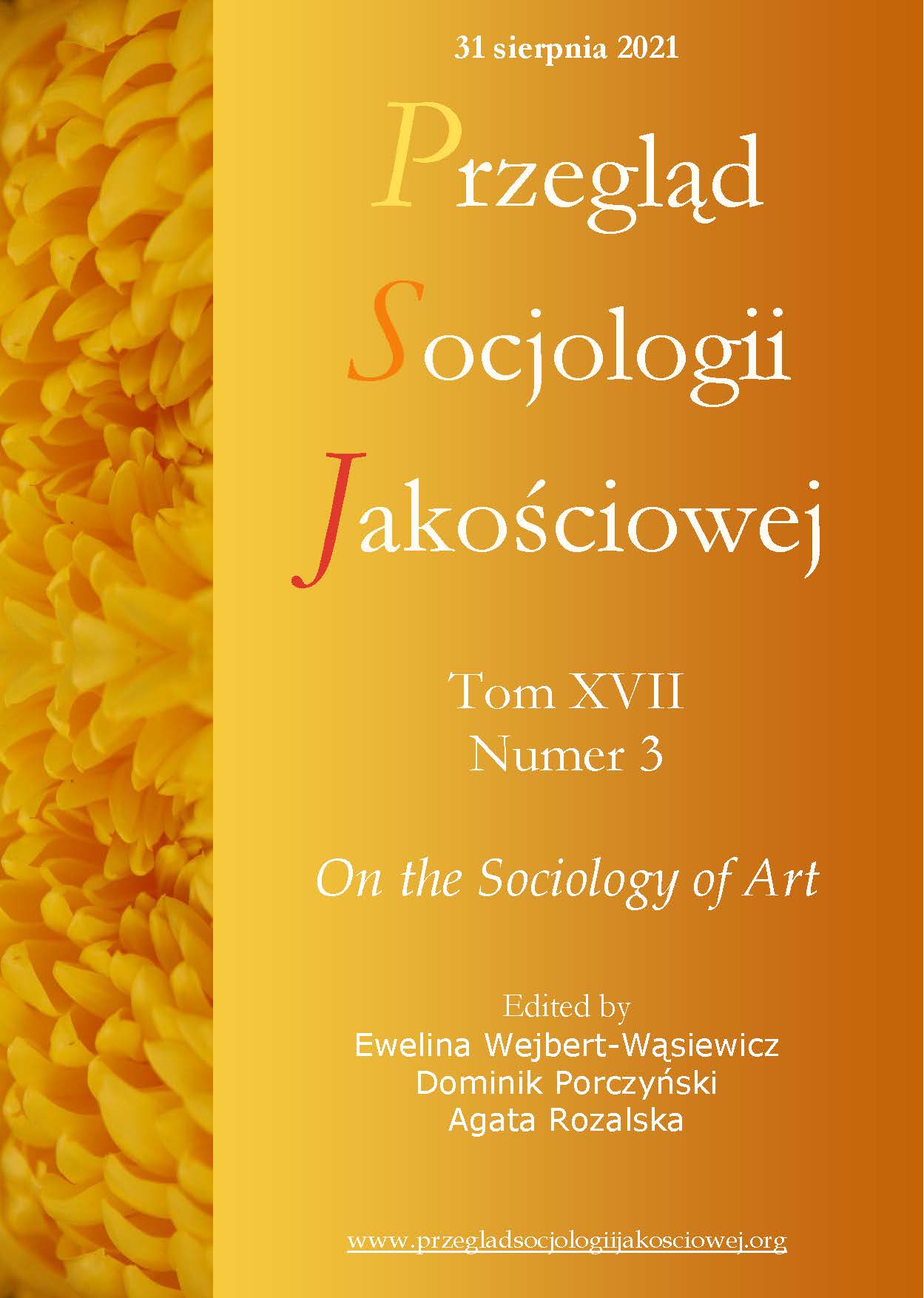Dilip Kumar: An Auteur Actor
DOI:
https://doi.org/10.18778/1733-8069.17.3.12Keywords:
Howard Becker, Dilip Kumar, Film Studies, Art and Culture, Sociology of Work, Film and CultureAbstract
Dilip Kumar has been praised for his sublime dialog delivery, for his restrained gestures, and for his measured and controlled underplay of emotions in tragic stories as well as in light-hearted comedies. His debut in 1944 with Jwar Bhata (Ebb and Tide) met with less-than-flattering reviews. So did the next three films until his 1948 film, Jugnu (Firefly), which brought him recognition and success. Unlike his contemporaries such as Raj Kapoor and Dev Anand, who propelled their careers by launching their own production companies, Dilip Kumar relied on his talent, his unique approach to characterization, and his immersion in the projects he undertook. In the course of his career that spanned six decades, Kumar made only 62 films. However, his work is a textbook for other actors that followed. Not only did he bring respectability to a profession that had been shunned by the upper classes in India as a profession for “pimps and prostitutes,” but he also elevated film-acting and filmmaking to an academic discipline, making him worthy of the title ‘Professor Emeritus of Acting’. Rooted in the theoretical framework of Howard S. Becker’s work on the “production of culture” and “doing things together,” this paper discusses Kumar’s approach to acting, character development, and the level of his involvement and commitment to each of his projects. The author of this article argues that more than the creative control as a producer or a director, it is the artistic involvement and commitment of the main actors that shape great works of art in cinema. Dilip Kumar demonstrated it repeatedly.
Downloads
References
Ahmad, Syed Areesh. 2019. “Remembering Dilip Kumar on his 97th birthday.” Retrieved June 23, 2021 https://www.asiaville.in/article/remembering-dilip-kumar-on-his-97th-birthday-23844
Google Scholar
Ayaz, Shaikh. 2018. “The glorious legacy of Dilip Kumar, arguably the subcontinent’s first method actor.” The Indian Express. Retrieved June 23, 2021 https://indianexpress.com/article/entertainment/bollywood/glorious-legacy-of-dilip-kumar-first-method-actor-5487659/
Google Scholar
Becker, Howard S. 1982. Art Worlds. Berkeley: University of California Press.
Google Scholar
Becker, Howard S. 1986. Doing Things Together: Selected Papers. Evanston: Northwestern University Press.
Google Scholar
Bollywood Aaj Aur Kal. 2020. “Naushad Ji talks about Dilip Kumar Sahib - Part-5 - Bollywood Aaj Aur Kal.” Retrieved June 23, 2021 https://www.youtube.com/watch?v=VlYzReIKn-w
Google Scholar
Chakravarty, Sumita. 1993. National Identity in Popular Indian Cinema – 1947-1987. Austin: University of Texas Press.
Google Scholar
Chung, Sonya. 2010. “I Heart Chekhov; Better Than Booze or Smokes.” The Millions. Retrieved June 23, 2021 https://themillions.com/2010/05/i-heart-chekhov-better-than-booze-or-smokes.html
Google Scholar
Cole, Nicki Lisa. 2019. “The Life and Work of Howard S. Becker” ThoughtCo. Retrieved June 23, 2021 https://www.thoughtco.com/howard-becker-3026481
Google Scholar
Desai, Meghnad. 2005. Nehru’s Hero: Dilip Kumar in the Life of India. New Delhi: Roli Books.
Google Scholar
“Dilip Kumar Interview.” 2018. Prasar Bharati Archives. Retrieved June 23, 2021 https://www.youtube.com/watch?v=6b8HnWsTreU
Google Scholar
Farookh, M. B. 2020. “The Kohinoor in the Crown of Indian Cinema.” Mouthshut.com Retrieved June 23, 2021 https://www.mouthshut.com/review/Dilip-Kumar-review-rmnplllnsno
Google Scholar
Guback, Thomas. 1969. The International Film Industry. Bloomington: Indiana University Press.
Google Scholar
Gupta, Rajan Das. 2010. “There’s method in his acting.” The Tribune. Retrieved June 23, 2021 https://www.tribuneindia.com/2010/20100627/spectrum/main7.htm
Google Scholar
Kahlon, Sukhpreet. 2019. “Jwar Bhata (1944): When Dilip Kumar’s performance got him a zero.” Cinestaan. Retrieved June 23, 2021 https://www.cinestaan.com/articles/2019/nov/29/23410/jwar-bhata-1944-when-dilip-kumar-s-performance-got-him-a-zero
Google Scholar
Kumar, Dilip. 2014. The Substance and the Shadow. An Autobiography. New Delhi: Hay House Publishers.
Google Scholar
Kumar, Dilip. 2016. “Dilip Kumar on Bimal Roy and Devdas.” Dailyo.in. Retrieved August 19, 2021 https://www.dailyo.in/arts/bimal-roy-dilip-kumar-devdas-nasreen-munni-kabir-the-silent-thunder-channel-4-uk/story/1/8341.html
Google Scholar
Lent, John. 1990. The Asian Film Industry. Austin: University of Texas Press.
Google Scholar
Mahaan, Deepak. 2010. “Aadmi (1968).” The Hindu. Retrieved June 23, 2021 https://www.thehindu.com/features/cinema/Aadmi-1968/article16576648.ece
Google Scholar
Naipaul, Vidiadhar S. 1977. India: A wounded civilization. New York: Vintage Books.
Google Scholar
Nazir, Asjad. 2019. “A legendary actor in his own words.” EasternEye. Retrieved June 23, 2021 https://www.easterneye.biz/a-legendary-actor-in-his-own-words/
Google Scholar
Rangan, Baradwaj. 2014. “The King of Tragedy.” The Hindu. Retrieved June 23, 2021 https://www.thehindu.com/books/books-reviews/review-of-dilip-kumar-autobiography/article6258685.ece
Google Scholar
Rishi, Tilak. 2012. Bless You, Bollywood!: A Tribute to Hindi Cinema on Completing 100 Years. Bloomington: Trafford Publishing.
Google Scholar
The News. 2013. “Dilip Kumar… in his own words.” Retrieved June 23, 2021 https://www.thenews.com.pk/tns/detail/554372-dilip-kumarin-words
Google Scholar
Downloads
Published
How to Cite
Issue
Section
License

This work is licensed under a Creative Commons Attribution-NonCommercial-NoDerivatives 4.0 International License.














